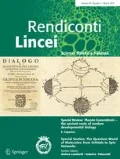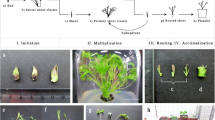Abstract
Crataeva L., an important genus of the Capparidaceae family, consists of medium-sized deciduous trees used in various medicinal systems. The attractive flowers also make it a novel ornamental tree for gardening and landscaping. In vitro propagation strategies are useful for large-scale propagation and standardization of plant material and, once an effective tissue culture system has been established, can be used for long-term preservation of important germplasm through cryopreservation. This review provides up-to-date information on micropropagation studies of Crataeva species and perspectives for their conservation.

Similar content being viewed by others
References
Aynilian GH, Farnsworth NR, Persinos GJ (1972) Isolation of lupeol from Crataeva benthamii. Phytochemistry 11:2885–2886. doi:10.1016/S0031-9422(00)86535-8
Babbar SB, Jain R, Walia N (2005) Guar gum as a gelling agent for plant tissue culture media. In Vitro Cell Dev Biol Plant 41:258–261. doi:10.1079/IVP2005628
Babbar SB, Walia N, Kaur A (2009) Large-scale in vitro multiplication of Crataeva nurvala. In: Protocols for in Vitro Cultures and Secondary Metabolite Analysis of Aromatic and Medicinal Plants. Methods in Molecular Biology (Vol 547), Humana Press, Totowa, pp 61–70. doi:10.1007/978-1-60327-287-2_5
Bani S, Kaul A, Khan B, Ahmad SF, Suri KA, Gupta BD, Satti NK, Qazi GN (2006) Suppression of T lymphocyte activity by lupeol isolated from Crataeva religiosa. Phyther Res 20:279–287. doi:10.1002/ptr.1852
Basu MJ, Ramanathan R, Yogananth N, Baburaj S (2009) Micropropagation of Crataeva religiosa Hook. f. & Thoms. Curr Trendzs Biotechnol Pharm 3:287–290
Benniamin A, Manickam VS, Johnson M, Joseph LH (2004) Micropropagation of Crataeva magna (Lour.) DC.: a medicinal plant. Indian J Biotechnol 3:136–138
Bhattacharjee A, Shashidhara SC, Aswathanarayana (2012) Phytochemical and ethno-pharmacological profile of Crataeva nurvala Buch-Ham (Varuna): a review. Asian Pac J Trop Biomed 2:S1162–S1168. doi: 10.1016/S2221-1691(12)60379-7
Bopana N, Saxena S (2008) Crataeva nurvala: a valuable medicinal plant. J Herbs Spices Med Plants 14:107–127. doi:10.1080/10496470802341532
Bopana N, Saxena S (2009) In vitro regeneration of clonally uniform plants of Crataeva magna: a high value medicinal tree by axillary branching method. New For 38:53–65. doi:10.1007/s11056-009-9131-1
Buchanan-Hamilton F (1872) Crataeva nurvala. Trans Linn Soc London 15:121
Cloutier S, Landry BS (1994) Molecular markers applied to plant tissue culture. In Vitro Cell Dev Biol Plant 30:32–39. doi:10.1007/BF02632117
de Candolle AP (1824a) Crateva adansonii. Prodromus Syst Nat Regni Veg 1:243
de Candolle AP (1824b) Crateva magna. Prodromus Syst Nat Regni Veg 1:243
Forster G, Dietrich JC (1786) Crataeva religiosa. Florulae Insul. Aust. Prodromus. Göttingen, Germany, p 35
Gamborg OL, Miller RA, Ojima K (1968) Nutrient requirements of suspension cultures of soybean root cells. Exp Cell Res 50:151–158. doi:10.1016/0014-4827(68)90403-5
Gupta P, Patel N, Bhatt L, Zambare GN, Bodhankar SL, Jain BB, Nandakumar K (2006) Anti-urolithiatic effect of petroleum ether extract stem bark of Crataeva adansonii in rats. Pharm Biol 44:160–165. doi:10.1080/13880200600686400
Igoli NP, Clements CJ, Singla RK, Igoli JO, Uche N, Gray AI (2014) Antitrypanosomal activity and docking studies of components of Crateva adansonii DC leaves: novel multifunctional scaffolds. Curr Top Med Chem 14:981–990. doi:10.2174/1568026614666140324120006
Inamdar JA, Nataraj M, Mohan JSS, Subramanian RB (1990) Somatic embryogenesis from callus cultures of Crataeva nurvala Buch. Ham. Phytomorphology 40:319–322
Khare CP (ed) (2007) Indian medicinal plants: an illustrated dictionary. doi: 10.1007/978-0-387-70638-2
Kiruba S, Mahesh M, Paul ZM, Jeeva S (2011) Preliminary phytochemical screening of the pericarp of Crataeva magna (Lour.) DC.—a medicinal tree. Asian Pac J Trop Biomed 1:129–130. doi:10.1016/S2221-1691(11)60139-1
Knop W (1865) Quantitative Untersuchungen über den Ernährungs prozess der Pflanzen. Landwirtsch Vers Stn 7:93–107
Kuvar NA, Lambole VB, Shah BN, Shah PK, Shah DP (2013) A valuable medicinal plant—Crataeva nurvala. Pharma Sci Monit 4:210–227
Leifert C, Cassells AC (2001) Microbial hazards in plant tissue and cell cultures. In Vitro Cell Dev Biol Plant 37:133–138. doi:10.1007/s11627-001-0025-y
Linnaeus C (1753) Crateva. Species Plant 12:444–454
Linsmaier EM, Skoog F (1965) Organic growth factor requirements of tobacco tissue cultures. Physiol Plant 18:100–127. doi:10.1111/j.1399-3054.1965.tb06874.x
Lloyd G, McCown B (1980) Commercially-feasible micropropagation of mountain laurel, Kalmia latifolia, by use of shoot-tip culture. Int Plant Propagators’ Soc Proc 30:421–427
Loureiro de J (1790) Capparis magna (Lour.). Flora Cochinchinensis 1:33
Murashige T, Skoog F (1962) A revised medium for rapid growth and bioassays with tobacco tissue cultures. Physiol Plant 15:473–497. doi:10.1111/j.1399-3054.1962.tb08052.x
Panwar S, Vashistha BD (2008) Effect of some auxins on regenerative potential of various parts of Crataeva nurvala Buch.-Ham. Ann Agri Bio Res 13:103–113
Panwar D, Singh M, Rathore MS, Shekhawat NS (2009) In vitro studies and micropropagation of Anacyclus pyrethrum and Crataeva nurvala. In: Kumar A, Shekhawat NS (eds) Plant issue culture and molecular markers their role in improving crop improvement. I K International, New Delhi, pp 227–232
Prakash A, Kumari S, Utkarshini Sinha K, Kumar S (2014) Direct and callus mediated regeneration from nodal and internodal segment of Crataeva religiosa G. Forst. var nurvala (Buch.-Ham.) Hook. f. & Thomson. Indian J Biotechnol 13:263–267
Raghavan TS, Venkatasubban KR (1941) Studies in the Capparidaceæ. VII. The floral morphology of Crataeva religiosa Forst. Proc Natl Acad Sci India Sect B Biol Sci 13:235–243
Sakai A, Kobayashi S, Oiyama I (1990) Cryopreservation of nucellar cells of navel orange (Citrus sinensis Osb. var. brasiliensis Tanaka) by vitrification. Plant Cell Rep 9:30–33. doi:10.1007/BF00232130
Sanayaima RK, Kaur A, Agrawal A, Babbar SB (2006) Cryopreservation of in vitro-grown shoot tips of Crateva nurvala Buch. Ham, an important medicinal tree. CryoLetters 27:375–386
Sharma V, Padhya MA (1996) In vitro rapid multiplication and propagation of Crataeva nurvala. Indian J Exp Biol 34:243–246
Sharma PK, Tyagi P, Sharma KC, Kothari SL (2003) Clonal micropropagation of Crataeva adansonii (DC.) Prodr.: a multipurpose tree. In Vitro Cell Dev Biol Plant 39:156–160. doi:10.1079/IVP2002384
Sharma SB, Rana A, Chauhan SVS (2006) Reproductive biology of Crataeva religiosa Forst. Curr Sci 90:716–720
Shirin F, Maravi S (2006) Clonal propagation of an important medicinal tree Crataeva nurvala through enhanced axillary branching. J Herbs Spices Med Plants 12:165–174. doi:10.1300/J044v12n01_15
Shirwaikar A, Setty M, Bommu P (2004) Effect of lupeol isolated from Crataeva nurvala Buch.- Ham. stem bark extract against free radical induced nephrotoxicity in rats. Indian J Exp Biol 42:686–690
Siddique HR, Saleem M (2011) Beneficial health effects of lupeol triterpene: a review of preclinical studies. Life Sci 88:285–293. doi:10.1016/j.lfs.2010.11.020
Sridhar N, Mishra SM, Venkataraman S (2012) In vitro antioxidant activity of Crataeva magna Lour. D.C. bark extract. Asian Pacific J Trop Dis 2:S846–S848. doi:10.1016/S2222-1808(12)60277-1
Teixeira da Silva JA (2012a) Is BA (6-benzyladenine) BAP (6-benzylaminopurine)? Asian Australasian J Plant Sci Biotechnol 6:121–124
Teixeira da Silva JA (2012b) Callus, calluses or calli: multiple plurals? Asian Australas J Plant Sci Biotechnol 6:125–126
Teixeira da Silva JA, Bolibok H, Rakoczy-Trojanowska M (2007) Molecular markers in micropropagation, tissue culture and in vitro plant research. Genes Genomes Genomics 1:66–72
Teixeira da Silva JA, Winarto B, Dobránszki J, Zeng S (2015a) Disinfection procedures for in vitro propagation of Anthurium. Folia Hortic 27:3–14. doi:10.1515/fhort-2015-0009
Teixeira da Silva JA, Winarto B, Dobránszki J, Zeng S (2015b) Anther culture of Anthurium: a review. Acta Physiol Plant 37:173. doi:10.1007/s11738-015-1909-5
Thimijan RW, Heins RD (1983) Photometric, radiometric, and quantum light units of measure: a review of procedures for interconversion. HortScience 18:818–822
Tyagi P, Kothari SL (2005) Anther culture in Crataeva adansonii (DC.) Prodr. Phytomorphology 55:49–54
Tyagi P, Sharma PK, Kothari SL (2010) Micropropagation of Crataeva adansonii D.C. Prodr: an ornamental avenue tree. In: Jain SM, Ochatt SJ (eds) Protocols for in Vitro Propagation of Ornamental Plants. Methods in Molecular Biology (Vol. 589), Humana Press, New York, pp 39–46
Walia N, Sinha S, Babbar SB (2003) Micropropagation of Crataeva nurvala. Biol Plant 46:181–185. doi:10.1023/A:1022882006682
Walia N, Kaur A, Babbar SB (2007) An efficient, in vitro cyclic production of shoots from adult trees of Crataeva nurvala Buch. Ham. Plant Cell Rep 26:277–284. doi:10.1007/s00299-006-0239-x
Yadav RK, Yadav AS (2008) Phenology of selected woody species in a tropical dry deciduous forest in Rajasthan, India. Trop Ecol 49:25–34
Acknowledgments
The authors thank Dr. M.S. Rathore (CSMCRI, Bhavnagar, India) and Dr. Purnima Tyagi (University of Rajasthan, Jaipur, India) for providing PDF files of two references.
Author information
Authors and Affiliations
Corresponding authors
Ethics declarations
Conflict of interest
The authors have no conflicts of interest to declare.
Rights and permissions
About this article
Cite this article
Kher, M.M., Nataraj, M. & Teixeira da Silva, J.A. Micropropagation of Crataeva L. species. Rend. Fis. Acc. Lincei 27, 157–167 (2016). https://doi.org/10.1007/s12210-015-0478-2
Received:
Accepted:
Published:
Issue Date:
DOI: https://doi.org/10.1007/s12210-015-0478-2




